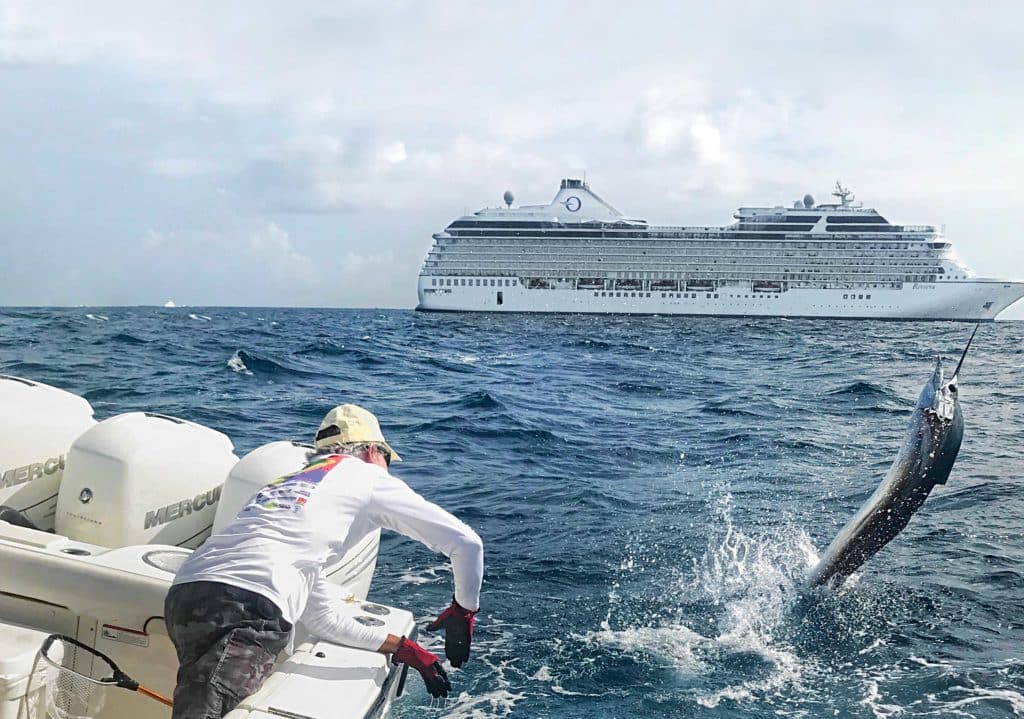
The morning’s first sailfish skirted all the 20-pound rods, and proceeded to devour a live herring flat-lined on the 12-pound outfit in our spread. Engel Coolers’ Paul Kabalin answered the challenge.
However, just prior to his hooking the sail, Reef Kabalin, Paul’s son, started battling a large hammerhead. With Reef’s shark trucking due south, and Paul’s sail now running full-steam to the east, we had a decision to make.
A billfish reigns supreme over most fish, at least on my boat. So Reef broke off the shark, enabling us to pursue his dad’s fish, which had already emptied half the spool on the reel.
The lengthy fight had us worrying about the 30-pound fluoro leader surviving the abuse. It did. Harry Vernon III billed the sailfish and removed the hook, and we idled forward until the sail was strong enough to swim free.
Back to the Ship
We repositioned for another identical drift between a freighter and cruise ship, both anchored off Miami’s Government Cut for over a week. Ironically, conditions weren’t ideal, with a very light current and cloudy greenish water. Yet, by playing off these ships, we ended the day after going 3 for 5 on sailfish, and boating two mid-20-pound blackfin tuna and a mutton snapper. There were also several skirmishes with sharks and barracuda.
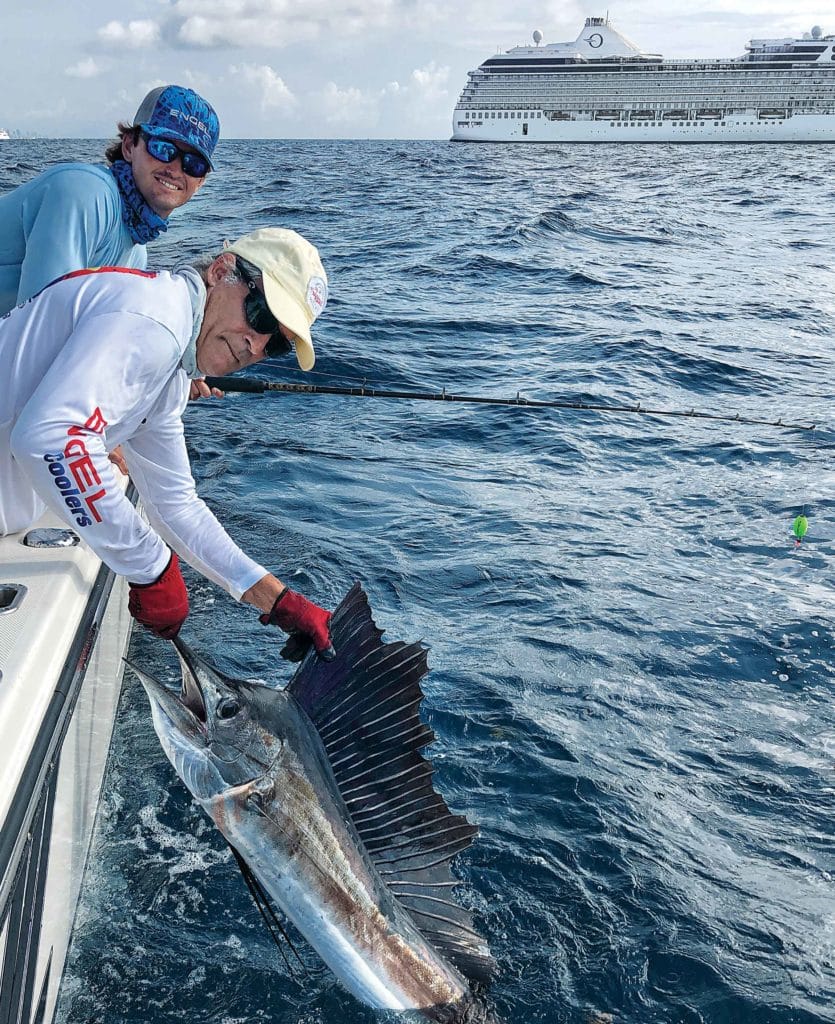
I’d fished along these same ships two days prior, with Carl Grassi and Rob “the Swede” Greene, and the second day with Grassi and Debbie Hanson. We raised sails each day, and boated blackfins up to 26 pounds. Despite the tight confines this location presents, Grassi caught a sailfish that charged under the bow of the anchored cruise ship and went out the other side, before turning back to come alongside our boat. As if on cue, it even went airborne several feet in front of a pair of ship workers on a scaffold. How the sail avoided the anchor chain remains a mystery.
Can’t Beat Those Buffets
These ships function as floating restaurants, offering forage for migrating fish, sailfish included. If food is abundant, pelagics may hang around for a day or more. These thriving ecosystems exist over relatively small zones, making them easy to fish. However, not all ships produce; certain conditions make them come alive.
Much like floating weed patches and debris, offshore eddies and temperature breaks, it’s all about the bait. The longer a ship remains at anchor, the more bait it attracts and holds.
The sheer mass of a ship, along with the deployed anchor and chain, attracts forage fish. Think of these massive ships as floating artificial reefs. The heaviest bait concentrations gather at night, under the stadium-like lighting. Goggle-eyes often congregate under anchored ships for multiple days. With this kind of buffet readily available, gamefish eagerly take advantage, even under marginal water conditions.
Sailfishing off South Florida focuses on rips, color changes, and zones where a solid northbound current flows, or over craggy bottom and structure. Knowledgeable sailfish anglers also incorporate ships as part of their routine, noting the depth and length of stay of those at anchor. They’ll often produce when open-water conditions are poor.
All Aboard
Capt. Dean Panos, with Double D Charters in Miami, seeks out ships anchored in 80- to 90-foot depths, rather than those in 40 to 50 feet.
“The deeper the water a freighter anchors in, the better it will be,” Panos says. “They rarely anchor beyond 90 feet. When they anchor shallower, it doesn’t bode well for the sailfishing. Without a doubt, if a ship is on the hook for one week or more, it bears investigating.
“I recall a large, red freighter—some six or seven years ago—that was anchored in 90 feet of water for a month, some 2 miles north of the sea buoy. Just about every time we’d go around that freighter, we’d catch a sail. We started catching sailfish around it one week after it anchored.”
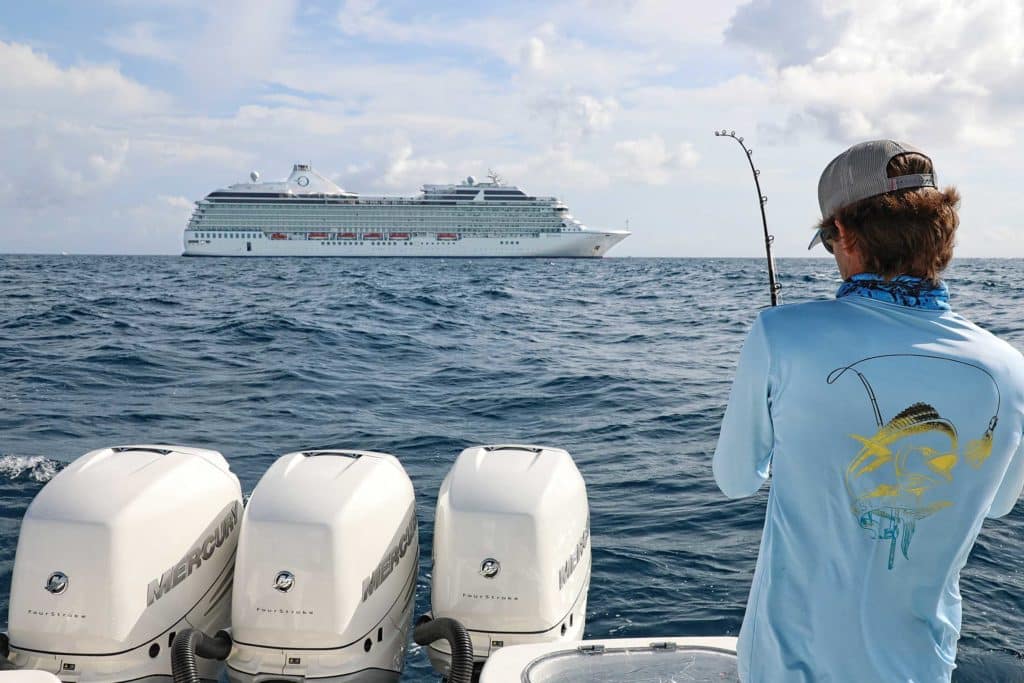
Panos reasons that the highly migratory sailfish rarely hang around these ships for long. Yet there always seems to be a few. “These sails are on the move,” he says. “The masses keep migrating, but a few detour and feed around the ships.”
Slick Ship Tricks
The typical live-bait strategies apply here: drifting with kites or bump-trolling.
When drifting, understand how wind and current will influence a pass around a ship. A prime drift shouldn’t be interrupted by repositioning the boat to avoid the ship. It’s simple geometry. Determine the straightest line to drift past the ship without coming dangerously close to it.
Panos says to be aware of how a hooked sailfish may run relative to the ship.
“Typically, sailfish run south and then east,” Panos says. “Big sails seem to always go west.”
Depending upon the boat’s position in relation to a ship, some fancy maneuvering may be required when a sail is hooked. Be wary of the anchor line too. Keep close to a hooked fish, and follow it around a ship to maintain clearance, if you’re in a position to do so. And always watch the fishing kites in relation to any ship.
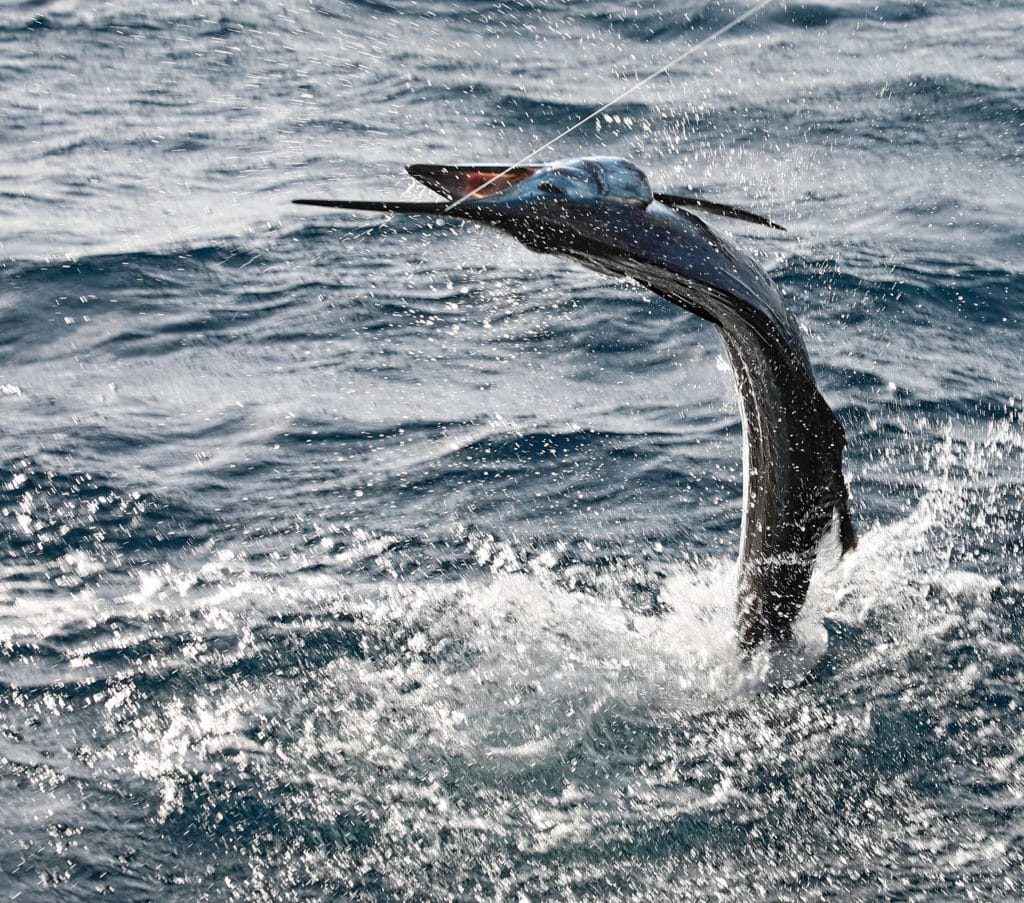
Over three days of fishing, this tactic initially factored in a drift between the two ships. In 200 feet with a southeast wind, out went three kite baits, along with a pair of free-lined liveys and two deep baits on the upwind side. Goggle-eyes graced the kite, with a mix of goggle-eyes, herring and pilchards on the flat lines.
The deep baits were staggered at 50 and 80 feet down. Leaders were 40-pound fluorocarbon, but a couple were swapped out for light wire in anticipation of kingfish.
The drift took us between the two ships, into 70 feet of water. We also made drifts along both sides of each ship.
If one drift produced, we’d repeat the pass following the chart plotter’s track line. In between, a number of sails, blackfins, kingfish, bonito, ‘cuda and sharks bent the rods. Ironically, when the sharks and barracuda became a menace, the sails and tunas weren’t far behind.
It’s that old adage of life breeding life. And that’s the beauty of fishing around anchored ships off Miami and other busy South Florida inlets.
Our goal around these ships is sailfish, but we welcome the variety of pelagics attracted to them as well.
This winter and spring, show these long-anchored, lonely ships some love. More than likely, they’ll love you back in grand fashion.
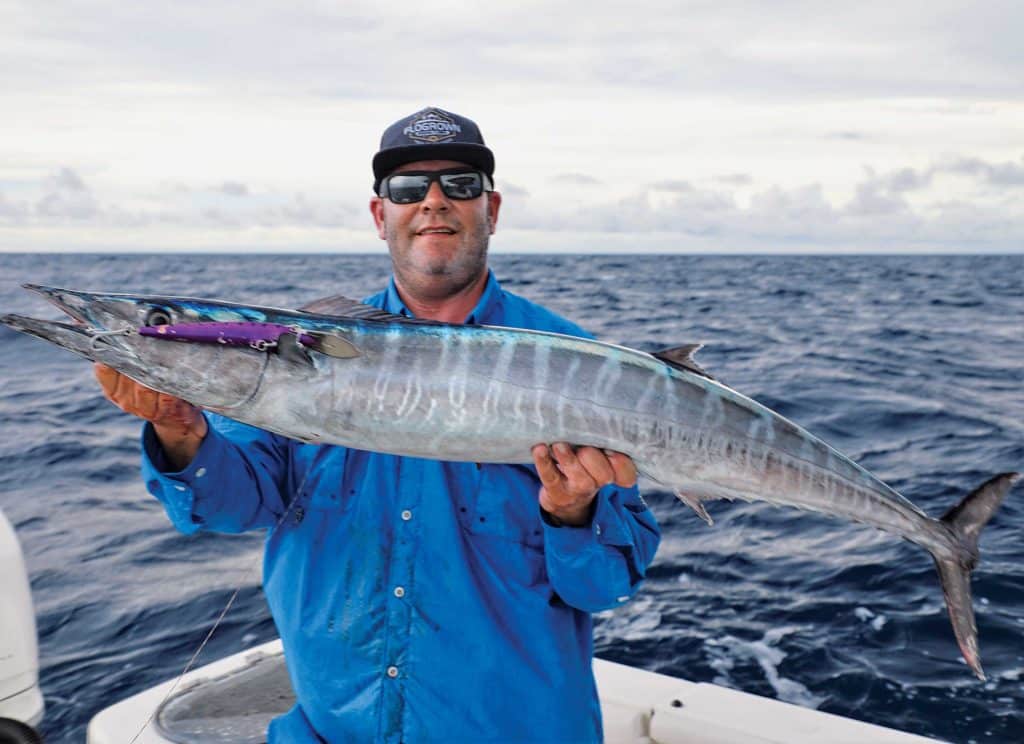
Where
South Florida
When
Winter through Spring
Who
Experienced live-baiters need only adapt their honed tactics to fish around the ships, treating them as huge floating artificial reefs. These captains can help dial in your technique:
Capt. Dean Panos, Double D Charters, 954-805-8231, doubledcharters.com
Capt. Ray Rosher, Miss Britt Charters, 305-596-0419, missbritt.com
Capt. Quinton Dieterle, Cutting Edge Sportfishing, 305-361-9740, miamicharterfishing.com
Plug Them Ships
Trolling a pair of deep-diving plugs alongside anchored ships is an excellent way to start or cap off the day with a wahoo, blackfin tuna or kingfish.
The best trolling bite occurs when a strong breeze pushes clean water tight against and under the deeper ships, early in the morning. Clean water and a strong current are ideal conditions for bait accumulations.
Deploy a pair of deep-diving plugs rigged on a few feet of No. 8 or No. 9 single-strand wire, or doubled single-strand wire to prevent kinking when trolling upward of 15 mph. Cable leaders work but stand out more; and while 100-pound mono elicits more strikes, you’re gambling against cutoffs.
My lures of choice are Rapala’s CD 18, and X-Rap Magnum 30 and 40. Colors do not seem as important as depth penetration and swimming action.
Hold the rod tips close to the water for maximum depth. Upon hooking up, keep the boat moving along and gradually away from the anchored ship; its running gear and anchor system aren’t conducive to landing long-running fish.
Reels: Penn Fathom or Torque Lever Drag 25, 30 or 40, or equivalent; Penn Spinfisher VI 7500 or 8500, Spinfisher VI LiveLiner 6500 or 8500, or equivalent
Rods: 7-foot, rated for 15- to 40-pound line
Lines: 12- to 20-pound mono
Leader: 40-pound fluorocarbon on 20-pound outfits; 30-pound fluoro on 12-pound outfits
Hooks: VMC Tournament circle, 4/0 to 7/0, sized for the bait
Baits: Live goggle-eyes, herring, pilchards









